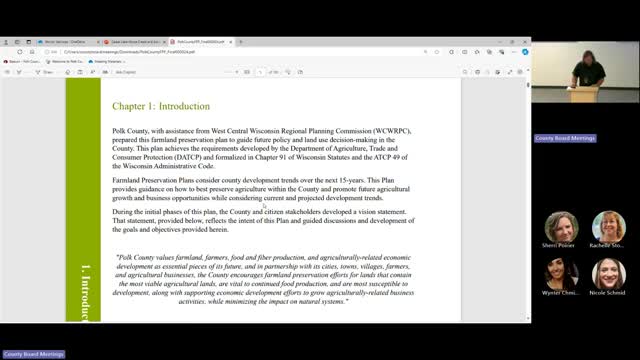County updates agricultural preservation plan to secure tax credits for landowners
October 02, 2024 | Polk County, Wisconsin
This article was created by AI summarizing key points discussed. AI makes mistakes, so for full details and context, please refer to the video of the full meeting. Please report any errors so we can fix them. Report an error »

Polk County is set to enhance its agricultural landscape with the approval of a new agricultural preservation plan, a crucial step for local farmers and the economy. During the Environmental Services Meeting on October 2, 2024, officials discussed the plan's purpose: to identify and protect vital agricultural lands while promoting agriculture as a key economic driver for the county.
This updated plan, required by the state of Wisconsin, allows agricultural property owners to access tax credits, providing financial incentives for land preservation. The last update occurred in 2014, and the new plan is essential for maintaining compliance with state regulations, ensuring that agricultural interests remain a priority in future economic development.
The planning process has been thorough, involving a year of collaboration with regional planning agencies and extensive stakeholder engagement. Local elected officials, agricultural producers, and various community members participated in meetings to provide input on the plan's vision, goals, and policies. This collaborative approach ensured that the plan reflects the needs and opinions of those directly involved in agriculture.
Key components of the plan include a land evaluation and site assessment tool, which identifies critical agricultural lands based on soil quality, population density, and existing agricultural use. Stakeholders contributed to refining this tool, ensuring it effectively highlights areas that should be preserved.
The plan specifically excludes incorporated cities and villages, which typically manage their own land use, focusing instead on unincorporated areas where agricultural preservation is most needed. Notably, the agricultural enterprise area in the southwestern part of the county has already received state commitment for long-term preservation, further solidifying the plan's objectives.
As Polk County moves forward with this agricultural preservation plan, it aims to secure the future of farming in the region, ensuring that agriculture continues to thrive as a cornerstone of the local economy. The next steps will involve finalizing the plan and implementing the strategies outlined to protect and enhance agricultural lands in the county.
This updated plan, required by the state of Wisconsin, allows agricultural property owners to access tax credits, providing financial incentives for land preservation. The last update occurred in 2014, and the new plan is essential for maintaining compliance with state regulations, ensuring that agricultural interests remain a priority in future economic development.
The planning process has been thorough, involving a year of collaboration with regional planning agencies and extensive stakeholder engagement. Local elected officials, agricultural producers, and various community members participated in meetings to provide input on the plan's vision, goals, and policies. This collaborative approach ensured that the plan reflects the needs and opinions of those directly involved in agriculture.
Key components of the plan include a land evaluation and site assessment tool, which identifies critical agricultural lands based on soil quality, population density, and existing agricultural use. Stakeholders contributed to refining this tool, ensuring it effectively highlights areas that should be preserved.
The plan specifically excludes incorporated cities and villages, which typically manage their own land use, focusing instead on unincorporated areas where agricultural preservation is most needed. Notably, the agricultural enterprise area in the southwestern part of the county has already received state commitment for long-term preservation, further solidifying the plan's objectives.
As Polk County moves forward with this agricultural preservation plan, it aims to secure the future of farming in the region, ensuring that agriculture continues to thrive as a cornerstone of the local economy. The next steps will involve finalizing the plan and implementing the strategies outlined to protect and enhance agricultural lands in the county.
View full meeting
This article is based on a recent meeting—watch the full video and explore the complete transcript for deeper insights into the discussion.
View full meeting
